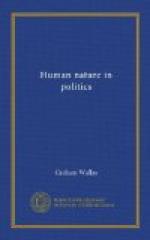Nor is the essence of the quantitative method changed when the answer is to be found, not in one, but in several ‘unknown quantities.’ Take, for instance, the question as to the best types of elementary school to be provided in London. If it were assumed that only one type of school was to be provided, the problem would be stated in the same form as that of the size of the Debating Hall. But it is possible in most London districts to provide within easy walking distance of every child four or five schools of different types, and the problem becomes that of so choosing a limited number of types as to secure that the degree of ‘misfit’ between child and curriculum shall be as small as possible. If we treat the general aptitude (or ‘cleverness’) of the children as differing only by more or less, the problem becomes one of fitting the types of school to a fairly exactly ascertainable polygon of intellectual variation. It might appear then that the best results would come from the provision, say, of five types of schools providing respectively for the 2 per cent, of greatest natural cleverness, the succeeding 10 per cent., the intermediate 76 per cent., the comparatively sub-normal 10 per cent., and the 2 per cent, of ’mentally deficient.’ That is to say the local authority would have to provide in that proportion Secondary, Higher Grade, Ordinary, Sub-Normal, and Mentally Deficient schools.
A general improvement in nutrition and other home circumstances might tend to ‘steepen’ the polygon of variation, i.e. to bring more children near the normal, or it might increase the number of children with exceptional inherited cleverness who were able to reveal that fact, and so ‘flatten’ it; and either case might make a change desirable in the best proportion between the types of schools or even in the number of the types.
It would be more difficult to induce a committee of politicians to agree on the plotting of curves, representing the social advantage to be obtained by the successive increments of satisfaction in an urban industrial population of those needs which are indicated by the terms Socialism and Individualism. They could, however, be brought to admit that the discovery of curves for that purpose is a matter of observation and inquiry, and that the best possible distribution of social duties between the individual and the state would cut both at some point or other. For many Socialists and Individualists the mere attempt to think in such a way of their problem would be an extremely valuable exercise. If a Socialist and an Individualist were required even to ask themselves the question, ‘How much Socialism’? or ‘How much Individualism’? a basis of real discussion would be arrived at—even in the impossible case that one should answer, ‘All Individualism and no Socialism,’ and the other, ‘All Socialism and no Individualism.’




